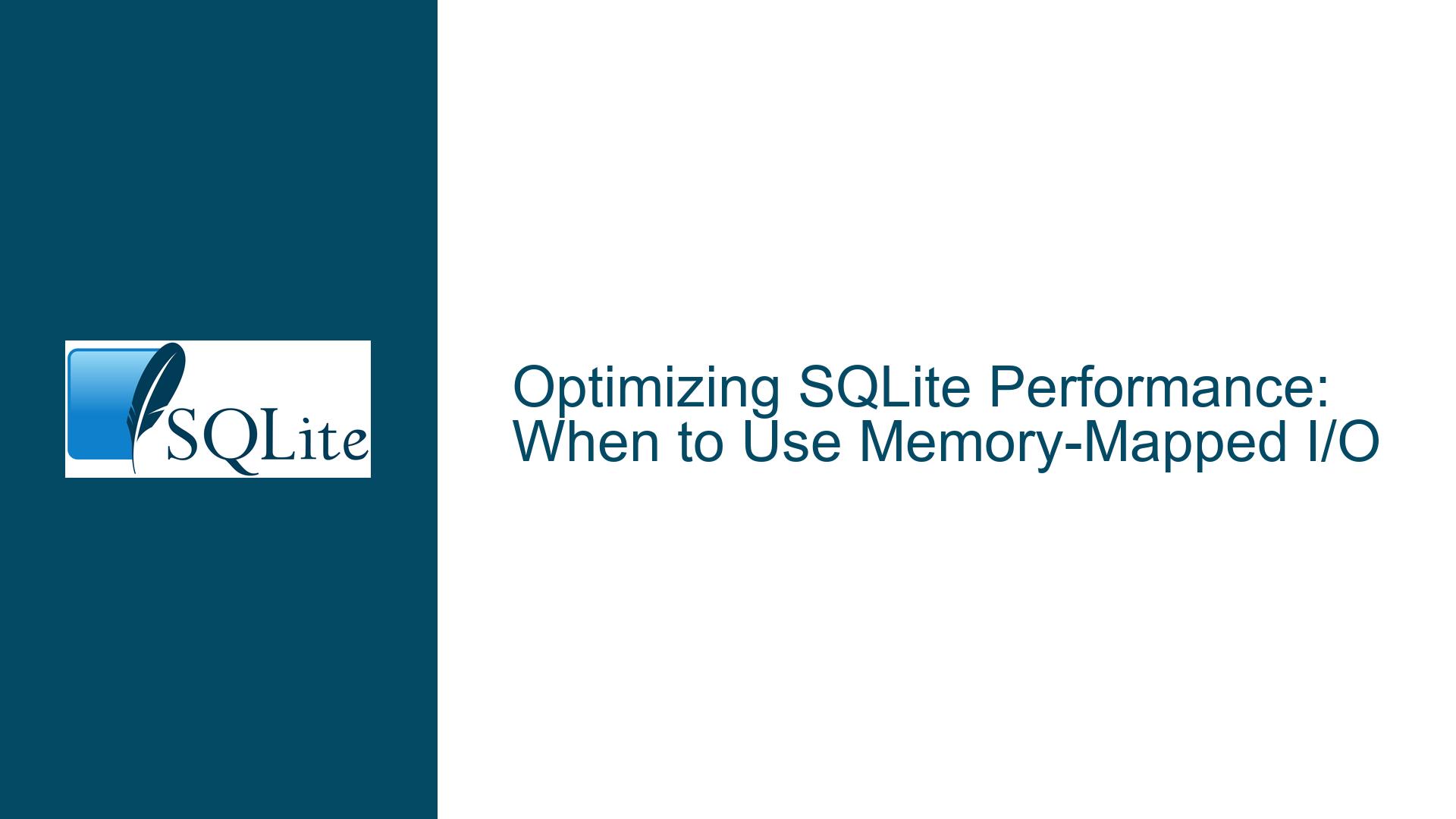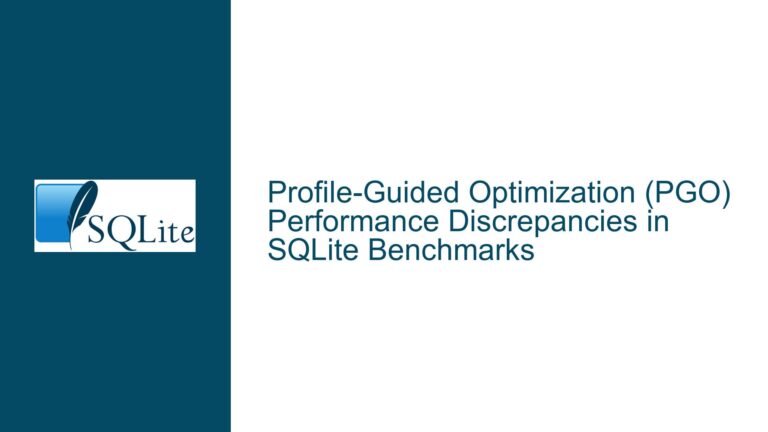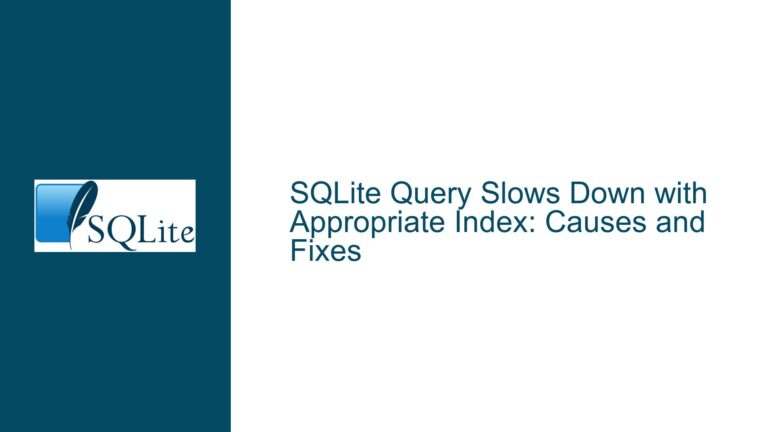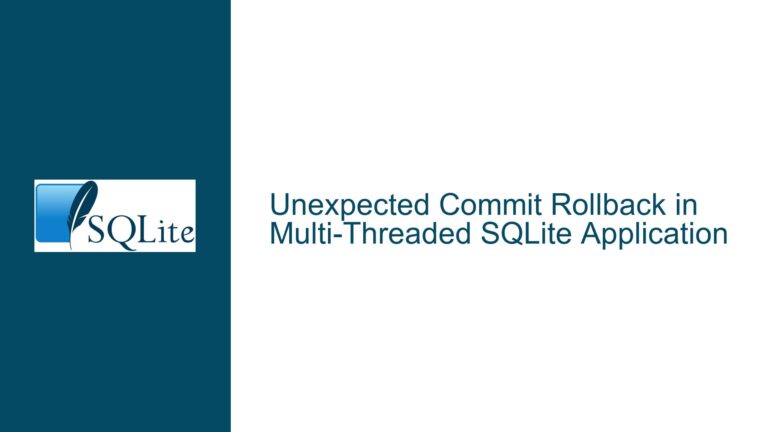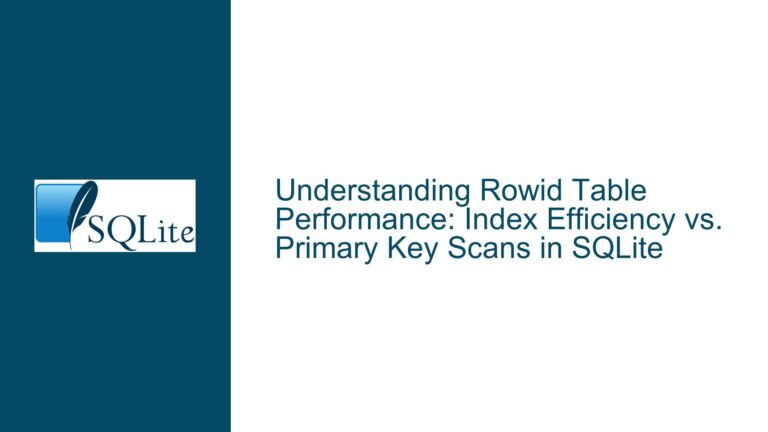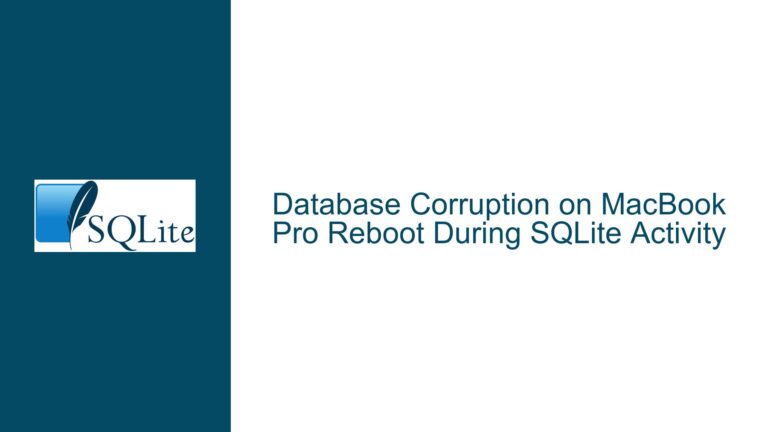Optimizing SQLite Performance: When to Use Memory-Mapped I/O
Memory-Mapped I/O Fundamentals and Performance Trade-offs
Memory-mapped I/O is a technique that allows a process to map a file on disk directly into its virtual address space. Instead of using traditional read/write system calls to access the file, the application interacts with the mapped memory region as if it were part of its own memory. This approach can reduce overhead by eliminating the need for explicit buffer management and system call transitions. However, its effectiveness in accelerating I/O operations depends on multiple factors, including the operating system’s virtual memory management, the hardware’s page caching capabilities, and the access patterns of the application. SQLite provides built-in support for memory-mapped I/O through the PRAGMA mmap_size directive, which configures the maximum number of bytes of the database file to map into memory.
The allure of memory-mapped I/O lies in its potential to bypass the SQLite page cache and leverage the operating system’s native page management. When a database page is accessed via memory mapping, the OS handles loading the page into RAM on demand. If the same page is accessed again shortly afterward, it may already reside in the OS page cache, avoiding a physical disk read. For read-heavy workloads with good temporal locality (repeated access to the same pages), this can reduce redundant I/O operations. However, this benefit is not universal. Write operations via memory mapping still require synchronization with the underlying file, and the OS may flush dirty pages to disk at unpredictable times, leading to performance variability. Furthermore, memory-mapped I/O does not inherently accelerate disk writes; it merely changes the mechanism by which data is transferred between user space and kernel space.
A critical misconception is that enabling memory-mapped I/O will universally improve performance. In reality, its impact is highly workload-dependent. Sequential scans of large datasets may benefit from reduced user/kernel context switches, but random access patterns in fragmented databases might degrade performance due to increased page faults. Additionally, memory-mapped I/O consumes virtual address space, which can be a limiting factor on 32-bit systems or when mapping very large databases. The SQLite documentation explicitly warns that performance gains are not guaranteed and provides scenarios where memory mapping might even degrade performance, such as when the working set exceeds available RAM, leading to thrashing.
Root Causes of I/O Bottlenecks and Misguided Optimization Efforts
Before considering memory-mapped I/O, it is essential to address higher-level inefficiencies that contribute to I/O pressure. The most common root causes of poor SQLite performance include suboptimal schema design, inefficient query execution plans, excessive index usage, and improper transaction management. For instance, a table without appropriate indexes may force full-table scans for simple queries, generating unnecessary I/O operations. Conversely, over-indexing can bloat the database file size, increasing the cost of write operations and checkpointing. Transaction boundaries also play a pivotal role: frequent small transactions incur significant overhead from journal synchronization, while batched transactions amortize this cost across multiple operations.
Another prevalent issue is the misuse of concurrency controls. SQLite uses a writer-exclusive locking model, meaning that write transactions block all other access to the database. Applications that interleave reads and writes without proper coordination may experience contention, leading to increased latency and I/O stalls. In multi-process environments, contention can escalate if the database is shared across applications without a mediating layer. Memory-mapped I/O does not resolve these issues; it merely alters how data is accessed once the I/O is unavoidable.
Hardware and filesystem limitations often exacerbate I/O bottlenecks. For example, using SQLite on a network-mounted filesystem or a storage medium with high latency (e.g., rotating hard drives) amplifies the cost of I/O operations. In such cases, optimizing the application to minimize disk access yields more significant benefits than switching to memory-mapped I/O. Additionally, the operating system’s page cache behavior can interact unpredictably with SQLite’s own caching mechanisms. If the working set exceeds the available RAM, both the OS page cache and the SQLite page cache will thrash, negating any potential benefits of memory mapping.
A subtler pitfall is the assumption that eliminating buffer copies via memory mapping will drastically reduce CPU overhead. While reducing memory copies can improve performance in CPU-bound workloads, most I/O-bound applications are limited by disk latency or throughput, not CPU cycles. The actual savings from avoiding buffer copies are often marginal compared to the time spent waiting for I/O completion. Furthermore, modern storage subsystems with advanced caching (e.g., SSDs with DRAM buffers) further diminish the relative impact of memory-mapped I/O optimizations.
Strategic Optimization Workflow: From Schema Tuning to Memory-Mapped I/O
Step 1: Analyze Query Patterns and Schema Design
Begin by profiling the application’s query patterns. Use SQLite’s EXPLAIN QUERY PLAN and .stats command to identify full-table scans, inefficient joins, or missing indexes. For example, a query that performs a full scan on a 10-million-row table could be accelerated by adding an index on the filtered column. However, ensure that indexes are justified: each additional index increases write amplification, as every INSERT/UPDATE/DELETE must update all relevant indexes. Utilize covering indexes where possible to avoid heap accesses.
Step 2: Optimize Transaction Management
Group multiple write operations into a single transaction to reduce the frequency of journal syncs. For bulk inserts, consider using BEGIN IMMEDIATE transactions to avoid contention and enable the write-ahead log (WAL) mode if concurrent reads are required. WAL mode separates writes into a separate log file, allowing readers to operate on a consistent snapshot without blocking. This can significantly reduce I/O contention in multi-threaded environments.
Step 3: Evaluate Hardware and Filesystem Configuration
Ensure the database resides on a filesystem with low latency and high throughput. Avoid network filesystems for write-intensive workloads. Configure the OS to allocate sufficient memory for caching, and consider using a RAM disk for temporary databases or in-memory storage. For persistent storage, prefer SSDs over HDDs to reduce seek times.
Step 4: Tune SQLite Configuration Parameters
Adjust the PRAGMA cache_size to increase the size of SQLite’s page cache, reducing the need for disk accesses. Experiment with PRAGMA synchronous settings to balance durability and performance (e.g., NORMAL for reduced fsync overhead). Enable memory-mapped I/O cautiously by setting PRAGMA mmap_size to a value that fits within the system’s virtual address space. Start with a conservative value (e.g., 64MB) and monitor performance using tools like iotop or vmstat to assess page fault rates and I/O wait times.
Step 5: Benchmark and Iterate
Use controlled benchmarks to measure the impact of each optimization. Compare the performance of memory-mapped I/O against traditional I/O under realistic workloads. If enabling memory mapping degrades performance, revert to default settings and focus on higher-level optimizations. Remember that the goal is to minimize the total number of I/O operations, not merely to change how they are performed.
In scenarios where memory-mapped I/O provides measurable benefits, integrate it as part of a holistic optimization strategy. For example, combine it with WAL mode and a sufficiently large page cache to maximize cache hit rates. Always validate optimizations under production-like conditions, as synthetic benchmarks may not reflect real-world behavior. By systematically addressing schema design, query efficiency, and transaction management before resorting to low-level I/O tweaks, developers can achieve substantial performance improvements without relying on uncertain optimizations like memory-mapped I/O.
